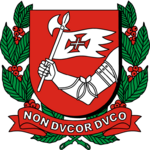Belmonte
United Republic of Belmonte República Unida de Belmonte (Lusitan) | |
|---|---|
| Motto: Non ducor, duco "I am not led, I lead" | |
| Anthem: Hino Nacional Belmontês "Belmontese National Anthem" | |
 Belmonte (green) in the Asterian Forum for Development and Cooperation (light green) in Asteria Inferior and Superior (grey) | |
 Political map of Belmonte | |
| Capital and largest city | Castelonovo |
| Official languages | Lusitan |
| Ethnic groups (2010) | See demographics |
| Demonym(s) | Belmontese |
| Government | Federal parliamentary republic |
| Caetano Villa-Lobos | |
| Rita Maurino | |
| Legislature | National Congress |
| Senate | |
| Chamber of Deputies | |
| Independence from Gaullica | |
• Declared | 07 August 1764 |
| 21 November 1771 | |
| 15 August 1764 | |
• Republic | 18 April 1819 |
| 06 December 1836 | |
| Area | |
• Total | 1,003,144 km2 (387,316 sq mi) |
| Population | |
• 2019 estimate | 19,880,143 |
• 2010 census | 17,346,974 |
• Density | 19.8/km2 (51.3/sq mi) |
| GDP (nominal) | 2019 estimate |
• Total | $385,038,610 |
• Per capita | $19,368 |
| Gini (2019) | medium |
| HDI (2019) | high |
| Currency | Cruzado (₡) |
| Time zone | Belmontese Central Time (BCT) |
| Driving side | right |
| Calling code | +76 |
| Internet TLD | .be |
Belmonte ([bewmɔnte]), officially the United Republic of Belmonte (Lusitan: República Unida de Belmonte) is a country located in the continent of Asteria Inferior, sharing borders with Nuvania to the west, Vilcasuamanas to the northwest, Satucin to the northeast and Nezquia to the east, as well as the Sublastrian Ocean to the south. With almost 20 million inhabitants and 1,003,144 km² (387,316 sq mi), Belmonte is considered to be one of the smallest countries of Asteria, both geographically and populationally, and is the only independent lusophone state in the world.
Before being colonized, the actual Belmontese territory was populated by several native peoples, the majority of them being from Tupi, Guaraní and Gê tribes. In 1503, by order of the Lusitan Crown, an expedition led by Duarte Bórgia started the process of colonization of Belmonte, which became divided into seven captaincies for administration purposes. Due to the lack of abundant precious metals in the region, the colony was neglected for various years, which delayed its development but made its autonomy increase. After the annexation of Lusitana by Florena, Belmonte was integrated into the new empire and had new administrative reforms, creating a more central system while maintaining its autonomy at the same time. With the defeat of Florena and the Treaty of Savona, Belmonte was transferred again to Gaullica, who ended the existent autonomy and created a totally central government which was very rejected by the population. This made Belmonte declare its independence in August 1764 with the support of regional elites, right after other Gaullican colonies made the same.
Under the leadership of Bento Mascarenhas, the country had its independence officially recognized in 1771 and developed into a confederation which existed for almost 50 years. After the Federalist Revolt, Belmonte became a presidential republic that over the time turned into an increasingly authoritarian state which culminated in the Belmontese Revolution in 1836. Despite that the 19th century was characterized for various advances in several fields, the first half of the 20th century was marked by instabilities, the Great Collapse and the invasion and occupation by the Entente during the Great War. After the end of the war, Belmonte passed through a series of reforms that modernized the country and, despite suffering from insurgencies in the 60s and 70s, has maintained political stability since then.
Today, Belmonte is a federal parliamentary republic with an emerging economy, having as chief of state the President Caetano Villa-Lobos and as chief of government the Prime Minister Rita Maurino while the national legislature is invested in the National Congress, which is divided into two houses: the Chamber of Deputies and the Senate. Its capital and biggest city is Castelonovo. Currently, Belmonte is a member-state of the Community of Nations, the Asterian Forum for Development and Cooperation, the International Council for Democracy, the International Trade Organization and the Global Institute for Fiscal Affairs.
Etymology
The word Belmonte is from Lusitan and Vespasian origin and means “beautiful mountain.” According to historians, the name was first used to designate the Monte de São Paulo, which was the first piece of land saw by Duarte Bórgia and his ships in the expedition that discovered Belmonte in 1503, with the name being officialized years later in 1508. During the time that the colony had been under Gaullican control, Belmonte had its name substituted by its Gaullican form, Beaumont, in official documents, although the name was never used by the population.

